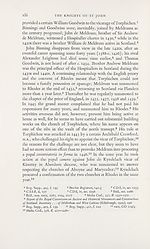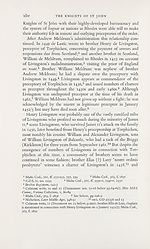Series 4 > Knights of St John of Jerusalem in Scotland
(48) Page xliii
Download files
Complete book:
Individual page:
Thumbnail gallery: Grid view | List view

INTRODUCTION
xliii
The survival of an interesting document in a fifteenth-century
Edinburgh cartulary1 provides an interesting illustration of the
relationship between Torphichen and the grand master of Rhodes
in the mid-fifteenth century. In consideration of the services which
he had performed both at Rhodes and across the sea, the master,
John de Lastic, in 1442 granted a pension from the fruits of Tor¬
phichen to a certain Scottish layman, called in the copy ‘Diguerus
le Scot’ (probably in the original Duguetus, i.e. Duguid). As it has
been represented to de Lastic that he cannot live comfortably on
the original pension, the grand master doubles the original grant,
ordering the preceptor of Torphichen to pay it out of the annual
responsion due to Rhodes from his Scottish house. The beneficiary
is not described as a brother of the order, though he had served at
Rhodes; he must have been a mercenary or non-noble fighting man
who had taken service with the Knights, and who had by this time
(1442) either been wounded or had grown old. He may have begun
his service in the household of Andrew Meldrum; the Scots name
Duguid was common in Udny, five miles east of Old Meldrum in
Aberdeenshire. Andrew Meldrum, sub virtute sancte obedientie, seems
to have complied with the master’s grant by passing his bull on to
the temple-bailie of Edinburgh, and the pension was presumably
paid out of the rents of the Hospitallers’ property in Edinburgh.
In 1454 the same man, called Duguetho le Scot alias de Scholia
servitori nostri had a confirmation of his pension from grand master
James de Milly on account of his years of service contra infideles.2
Clearly the elaborate organisation worked out by the Hospitallers
at Rhodes in the fourteenth century was still effective despite the
disruption of the Great Schism: while other institutions which
originated from the crusading movement were tending in the
fifteenth century to lose touch with their centres of authority,3 the
1 St Giles Registrum, 66-67. This bull is not entered in the surviving registers for 1442
at Malta
2 Malta Cod., 365, f. raor. Dr John Durkan suggests that Duguithus is a form of the
Aberdeenshire surname Duguid, a family with connections with Auchenhove
(Lumphanan) and Udny. Udny is just 5 miles from Old Meldrum, and the likelihood
is that Duguithus was a member of brother Andrew de Meldrum’s household who
made a career for himself at Rhodes after Meldrum returned to Scotland in 1433
3 See A. Macquarrie, ‘The Bethlehemite Hospital of St Germains, East Lothian’, East
Lothian Trans., xvii (1982), x-10
xliii
The survival of an interesting document in a fifteenth-century
Edinburgh cartulary1 provides an interesting illustration of the
relationship between Torphichen and the grand master of Rhodes
in the mid-fifteenth century. In consideration of the services which
he had performed both at Rhodes and across the sea, the master,
John de Lastic, in 1442 granted a pension from the fruits of Tor¬
phichen to a certain Scottish layman, called in the copy ‘Diguerus
le Scot’ (probably in the original Duguetus, i.e. Duguid). As it has
been represented to de Lastic that he cannot live comfortably on
the original pension, the grand master doubles the original grant,
ordering the preceptor of Torphichen to pay it out of the annual
responsion due to Rhodes from his Scottish house. The beneficiary
is not described as a brother of the order, though he had served at
Rhodes; he must have been a mercenary or non-noble fighting man
who had taken service with the Knights, and who had by this time
(1442) either been wounded or had grown old. He may have begun
his service in the household of Andrew Meldrum; the Scots name
Duguid was common in Udny, five miles east of Old Meldrum in
Aberdeenshire. Andrew Meldrum, sub virtute sancte obedientie, seems
to have complied with the master’s grant by passing his bull on to
the temple-bailie of Edinburgh, and the pension was presumably
paid out of the rents of the Hospitallers’ property in Edinburgh.
In 1454 the same man, called Duguetho le Scot alias de Scholia
servitori nostri had a confirmation of his pension from grand master
James de Milly on account of his years of service contra infideles.2
Clearly the elaborate organisation worked out by the Hospitallers
at Rhodes in the fourteenth century was still effective despite the
disruption of the Great Schism: while other institutions which
originated from the crusading movement were tending in the
fifteenth century to lose touch with their centres of authority,3 the
1 St Giles Registrum, 66-67. This bull is not entered in the surviving registers for 1442
at Malta
2 Malta Cod., 365, f. raor. Dr John Durkan suggests that Duguithus is a form of the
Aberdeenshire surname Duguid, a family with connections with Auchenhove
(Lumphanan) and Udny. Udny is just 5 miles from Old Meldrum, and the likelihood
is that Duguithus was a member of brother Andrew de Meldrum’s household who
made a career for himself at Rhodes after Meldrum returned to Scotland in 1433
3 See A. Macquarrie, ‘The Bethlehemite Hospital of St Germains, East Lothian’, East
Lothian Trans., xvii (1982), x-10
Set display mode to:
![]() Universal Viewer |
Universal Viewer | ![]() Mirador |
Large image | Transcription
Mirador |
Large image | Transcription
Images and transcriptions on this page, including medium image downloads, may be used under the Creative Commons Attribution 4.0 International Licence unless otherwise stated. ![]()
| Scottish History Society volumes > Series 4 > Knights of St John of Jerusalem in Scotland > (48) Page xliii |
|---|
| Permanent URL | https://digital.nls.uk/126638091 |
|---|
| Description | Over 180 volumes, published by the Scottish History Society, containing original sources on Scotland's history and people. With a wide range of subjects, the books collectively cover all periods from the 12th to 20th centuries, and reflect changing trends in Scottish history. Sources are accompanied by scholarly interpretation, references and bibliographies. Volumes are usually published annually, and more digitised volumes will be added as they become available. |
|---|


